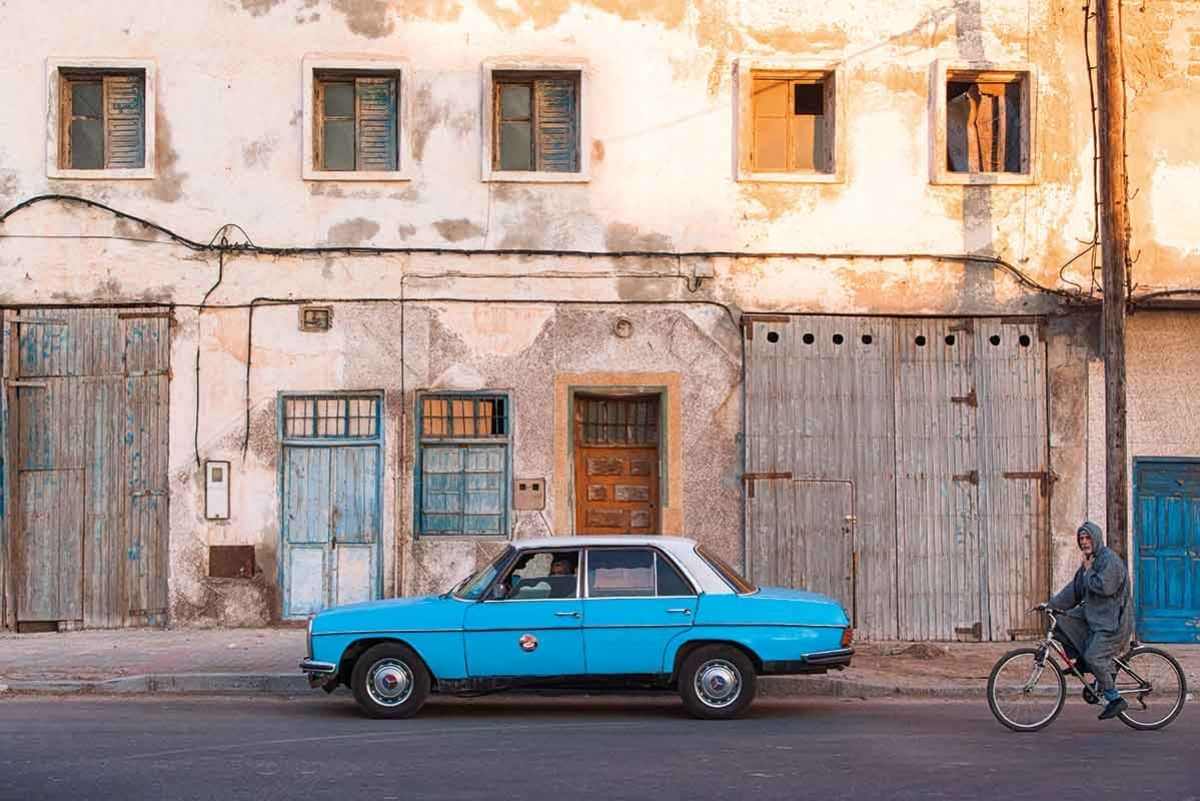
In Morocco, people don’t Uber, they pile into grand taxis – battered but colourful old diesel Mercedes cars. Now, the government is trying to force them off the streets
By John Silcox, photographs by Sam Christmas
The sun is still hiding behind weathered stone ramparts high above the old Moroccan port of Essaouira, but already, day-to-day business is well underway at the small city’s bustling Place des Grand Taxis. Drivers are demisting cracked windscreens with filthy wads of old newspaper while oil-covered mechanics attempt to coax weary engines back to life amid clouds of thick, blue smoke. Long-distance travellers are huddled together, waiting in small groups for a ride, their faces concealed from the cold by hooded woollen robes or djellabas.
Everyone is eager to get on the road early and escape the unrelenting heat of the day, which makes sitting in a cramped vehicle – with up to five other passengers, their luggage and driver – unbearable. So most eyes track the chief broker, who busily manages operations from a prominent position next to the entrance of the whitewashed compound, where a fleet of 30-odd sky-blue cars are parked. At regular intervals, he barks orders at both drivers and passengers, skilfully orchestrating proceedings using a rectangular piece of card on which he scores a long list of numbers, controlling every vehicle that comes in and out of this organised chaos.
Just before 8am, a particularly old taxi appears from behind a veil of dust, bouncing off the pot-holed road and mounting the low kerb that leads to the transport hub. After nonchalantly avoiding collision with an orange vendor’s cart and a skinny stray dog, the car crawls past the broker and finds a space at the back of the rank. Behind the wheel sits Hassan Mesfar, a well-known and much-loved character in the neighbourhood, who is instantly recognisable by the car he drives: a
1974 Mercedes ‘Stroke 8’. In the UK, such a vehicle would belong to a motor museum, but in Morocco, it’s just another rolling ruin. Still, this one boasts the dubious honour of being the oldest taxi in Essaouira – although not by much. It shares the tarmac with plenty of other battered and bruised diesel vehicles, all of them long due retirement.
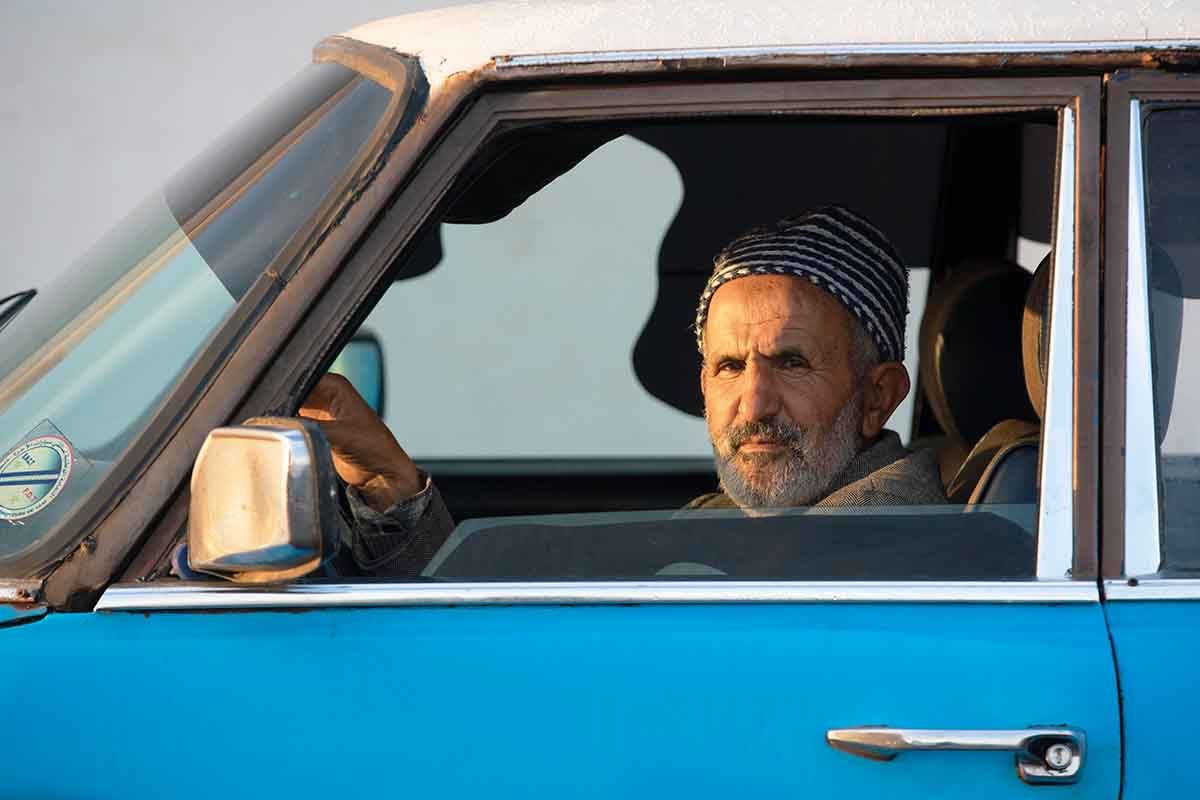
In this city, as all over the kingdom, many Mercedes 240Ds from the 1970s and ’80s have spent their twilight years in the sun, having been shipped over when they were deemed too old for the European market. Here they’re woven into the fabric of society, providing an essential long-distance travel link for locals, as well as a colourful snapshot for tourists, much like the old US cars in Cuba. But not for much longer. The Moroccan government is keen to remove them from the country’s roads. In 2014, it launched an incentive scheme that offers grand taxi drivers 80,000 dirhams (around £6,500) to scrap their old vehicles. So far, more than 56 per cent of the 45,000 grand taxis in service have been updated thanks to this programme – something the government aims to increase to 100 per cent by 2022.
‘It’s the end of an era,’ says Mesfar ruefully as he sits down to enjoy a coffee at his regular spot. Last night, he was late getting back from his journey and as is customary with the grand taxis’ first-in first-out system, he won’t be leaving until later in the day. ‘The government is offering us money to update our cars for shiny new Dacias, but for me, they’re not the same as my old Mercedes. It’s the best car I have ever driven – so solid, so reliable, so comfortable – and never lets me down. That’s why around here we call them “Merci dix”.’ In Moroccan French, this phrase literally translates as ‘thanks times ten’, but there’s also a play on words with the local pronunciation of Mercedes.
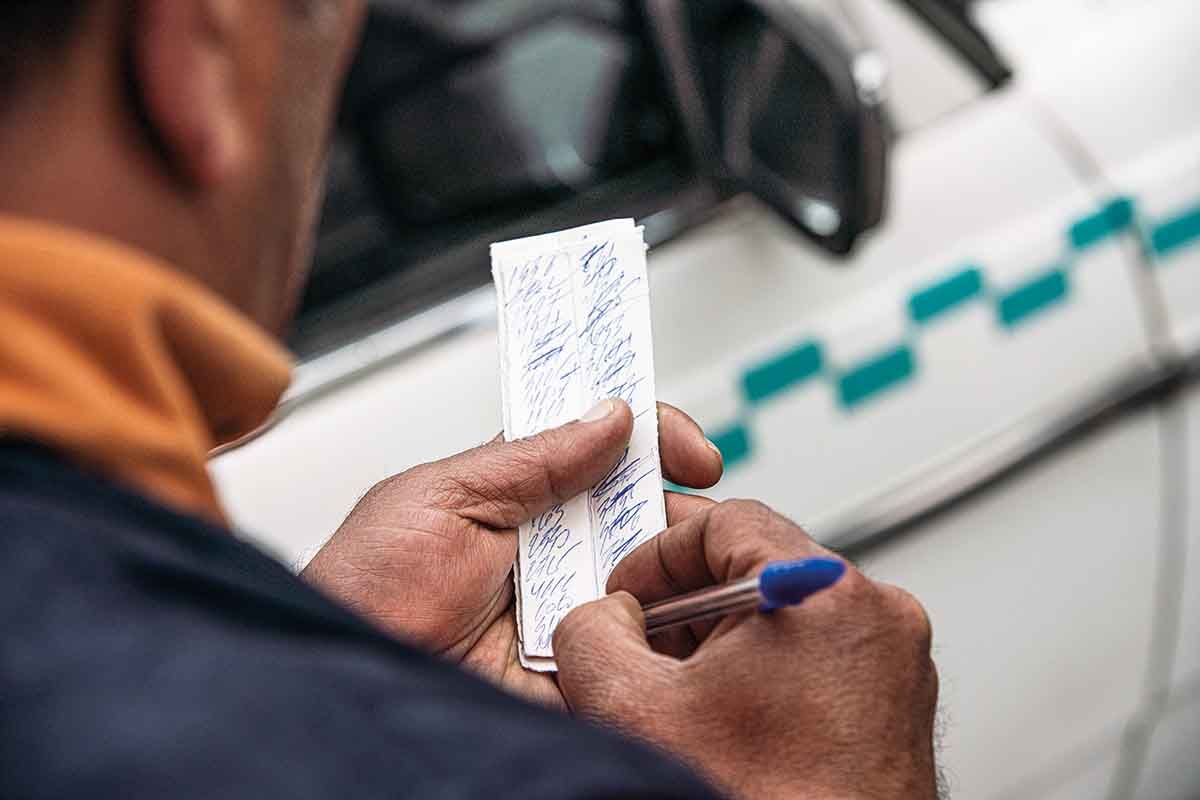
Hassan, who, like many taxi drivers, is a theatrical conversationalist, says the phrase by pursing his lips, lifting his chin and narrowing his dark eyes as if squinting into bright light. He then draws out the ‘r’ by pulling his face back into a grin, rattling through the other syllables and pushing out the final ‘s’ through near-closed teeth. All the while, jiggling his head and raising his hands in mock praise. It’s quite a performance.
Le grand taxi
To understand the impact of the new scheme on a national scale, it’s important to understand the wider role of taxis in Morocco. In a country of 36 million people, there are only 2.8 million registered cars: so only one car per 11 Moroccans. Nearby Spain, with a population of roughly ten million more, has more than 24 million vehicles on the road. Without rail or buses to provide a well-developed or affordable solution to the masses, grand taxis are the leading long-distance transport solution.
‘Le grand taxi is the backbone of Morocco,’ says Mesfar, proudly emphasising the essential role that he and his co-workers deliver. ‘Public transportation is next to nonexistent; there is only one train line and that’s up north. If you want to get to another city, you can take the bus, but departures are irregular, there are frequent accidents, it’s very slow and it only takes you to the big cities. That’s why people like to take grand taxis – because they’re nice and quick.’

The Place des Grand Taxis is much more than a simple taxi rank – it’s a main transport hub and each city in the country has one. Here in Essaouira, under the watchful eye of the chief broker, travellers on their way to a particular city up north are ushered into one taxi, those going south into another and so forth. Then, when all of the seats in a car have been taken, it can leave on its journey. Generally speaking, the more distant the destination, the earlier the departure. Most drivers prefer to return to their home base each night, despite the fact that they may have to travel upwards of 1,000 kilometres per day, although this isn’t always possible.
‘Look at the green taxi parked over there,’ says Mesfar. ‘That’s stayed overnight from Taroudant [a city to the west of Essaouira]. And that one over there is from Rabat as it’s white. Each city in Morocco has its own taxi colour scheme, which makes it easy to spot.’
Essaouria boasts a unique shade of blue that originally came from crushed seashells. Nearly everything in the city has been painted with it: from horse-drawn carriages to people’s front doors – even the petit taxis. This last point is unusual, as most other Moroccan cities chose different colours to differentiate petit taxis, which are smaller cars (usually French hatchbacks), only allowed to take a maximum of two passengers on much shorter rides within the urban perimeter.
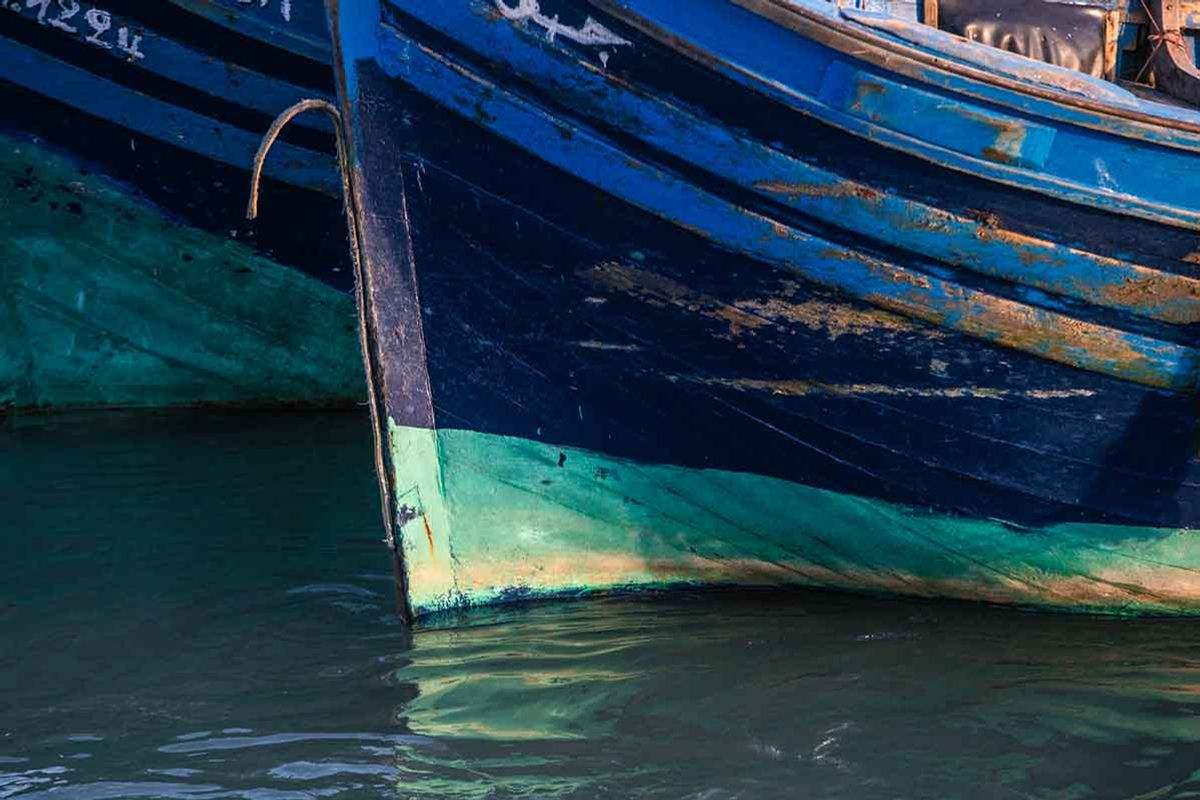
The world’s scrapyard
The love affair between Mercedes – the German automotive brand – and the North African kingdom dates back to the earliest days of the automobile. In 1892, Sultan Hassan I bought the first car ever made by Daimler (the company that owns Mercedes-Benz) and this royal endorsement has continued ever since. The current king, Mohammed VI, still uses a unique Mercedes Benz 600, passed down from his father, for state functions.
‘During the 1980s, Africa started to experience an influx of second-hand Mercedes cars,’ says Flavien Neuvy, an economist who specialises in the African automotive industry. ‘Moroccan taxi drivers simply started catching on to what cab owners in Europe had understood: diesel Mercedes were built to last.’
Mesfar’s Mercedes W114 ‘Stroke 8’ model was a game-changer for the Stuttgart-based manufacturer and 1.9 million rolled off the line during its eight years of production. Its successor, the W123, appeared in 1976 and even more were produced; 2.9 million of the cars were built in the nine years that followed.
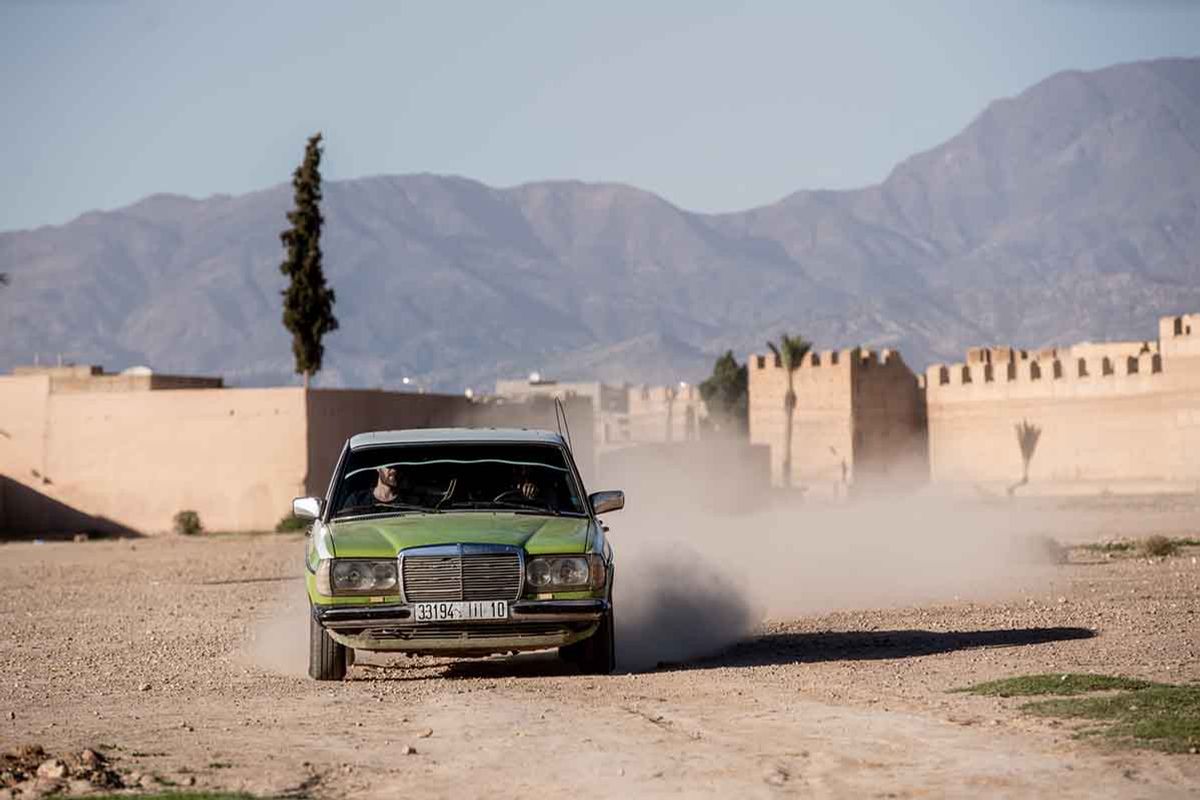
Back in the 1970s and ’80s the average age of cars in Europe was less than seven years. The relatively quick turnover meant that millions of robust and reliable Mercedes were being swapped for newer cars by their original owners and sold on the used-car market. Eventually, when they were deemed too old for European buyers, they were picked up at a discount by exporters and shipped off to the developing world, with Africa being the favourite destination.
In 2000, more than 70 per cent of all cars imported into Morocco were more than five years old, including many old Mercedes, which have enjoyed incredible longevity thanks to their robust mechanics, simple maintenance requirements and an abundance of salvaged spare parts. It was estimated that 35,000 W123 240Ds alone were still on Moroccan roads in 2011, more than 30 years after the last of the model rolled off the production line.
‘Africa is a hotbed of mechanical resourcefulness,’ says Neuvy. ‘Everything has a value, even if we would deem it rubbish in Europe. When things break, people always find a way to fix them. So Moroccan taxi drivers have many tricks up their sleeves to keep their vehicles on the road.’ One popular stratagem involves filling the car’s boot with large stones in order to limp home after breaking a prop shaft. The additional weight on the rear axle stabilises things, allowing the driver to keep the car on the road.
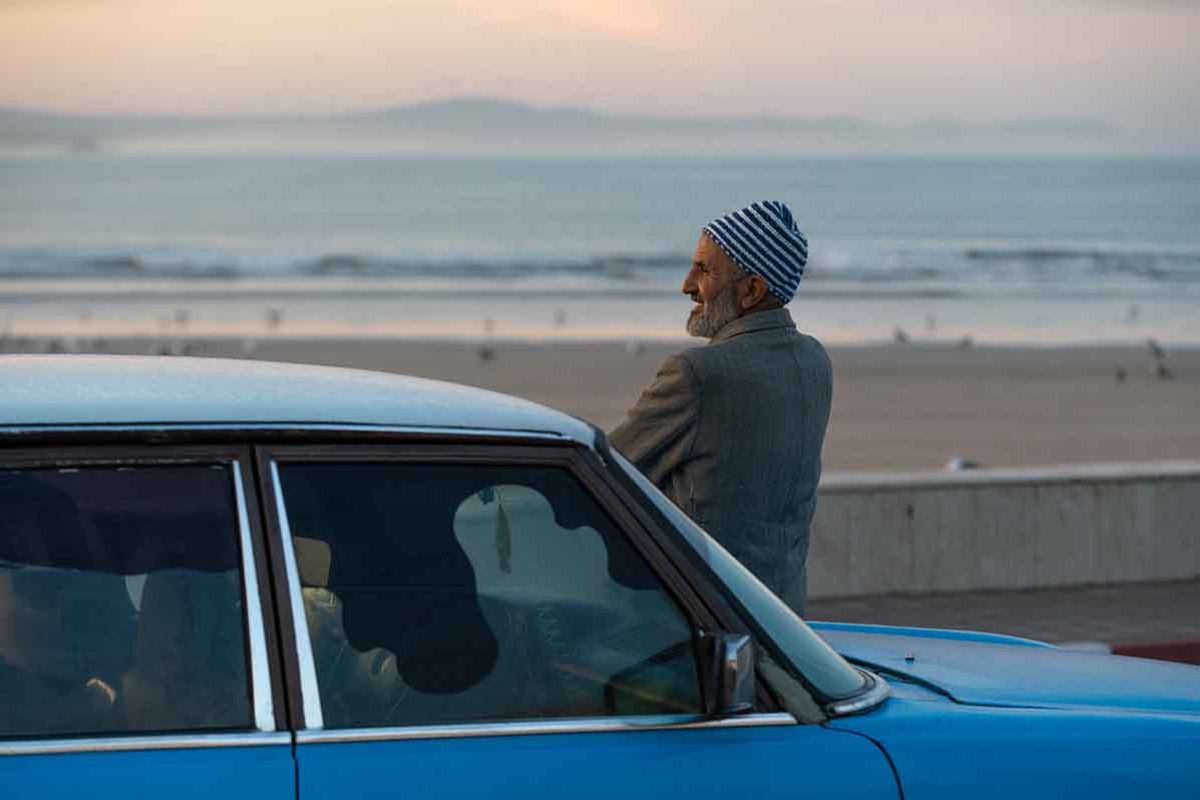
Cleaning the air
The downside of the Mercedes’ longevity is that while European drivers have enjoyed numerous generations of cleaner, more efficient vehicles, Moroccans have been suffering from increasingly bad air pollution. According to the Barcelona Institute for Global Health, mortality due to air pollution in the country has increased by 50 per cent since 1997. Vehicle emissions are the most significant source of air pollution in Moroccan urban centres, accounting for nearly 60 per cent of the total.
‘Some developing countries have some pretty hideous pollution problems in their cities,’ says Mike Berners-Lee, a leading expert in carbon footprinting. ‘With old diesel engines, there are two types of pollution: the type of pollution that clogs up your lungs and kills you and passersby with particulates; and then there’s carbon emissions, which affect climate change. In the UK alone, 40,000 people per year die of this first kind of pollution, so it’s definitely something that needs to be taken seriously.’
The Moroccan government’s response has been to implement a series of measures. In 2010, it banned the import of all cars more than five years old and increased tax duties on the sale of second-hand vehicles. Then, in 2014, it brought in the first cash-incentive scheme aimed at grand taxi drivers.
So far, the scheme hasn’t quite had the desired reach, with poor levels of uptake at its launch and multiple deadline extensions for ambitious targets ever since. Critics also point out that the government has other motivations for subsidising new car purchases, namely the fact that in recent years, the country has invested heavily in developing its own automobile production facilities. The North African kingdom is set to become one of the world’s big players in the automotive sector, with its vehicle-production industry poised to be worth about US$14 billion within the next five years. As of 2019, the automotive sector represented nearly 30 per cent of the country’s exports and already, one in five new car imports into Europe comes from Morocco.

French manufacturer Renault has historical links with the territory and benefits from support by the Moroccan government. It operates two plants in the north of the country. Production at these sites includes the seven-seater Dacia Lodgy, which is now the most commonly bought taxi in the country, representing one in every two new sales.
This sounds like a positive movement, given the heavy pollution associated with old diesel vehicles; however, according to Berners-Lee, it isn’t quite so simple. ‘From an embodied-carbon perspective, keeping these old Mercedes on the road is actually better than replacing them with new ones,’ he argues. ‘People often forget that producing new vehicles generates a lot of unseen carbon emissions, even though the end product spits out less from its tailpipe. So it’s important that we learn a lesson here about our attitude to new, efficient vehicles. The direct savings from the previous model must be significant enough to warrant renewal, otherwise we’re simply offsetting the problem to a different part of the vehicle’s life-cycle.’
There’s a balance to be had, but regardless of how it plays out, back in Essaouira, it’s going to take more than a few thousand dirhams and a shiny new car to make Hasan Mesfar change his ways. ‘I’m too old for anything new anyways,’ he says. ‘I’ll be retiring in a few years, so it would be a waste of money to upgrade. I also don’t think my customers would like it. And for me, it wouldn’t be the same job without my Mercedes. We’ve travelled so far, experienced so much and been on unforgettable adventures. It’s only fair that we reach the end of the road together.’




